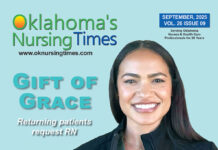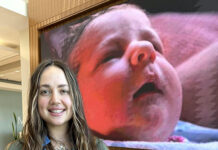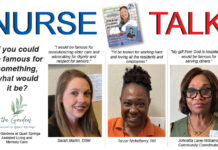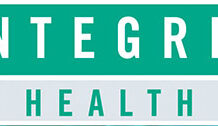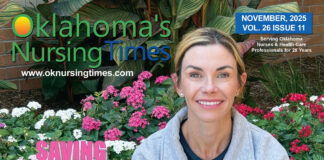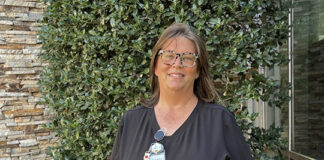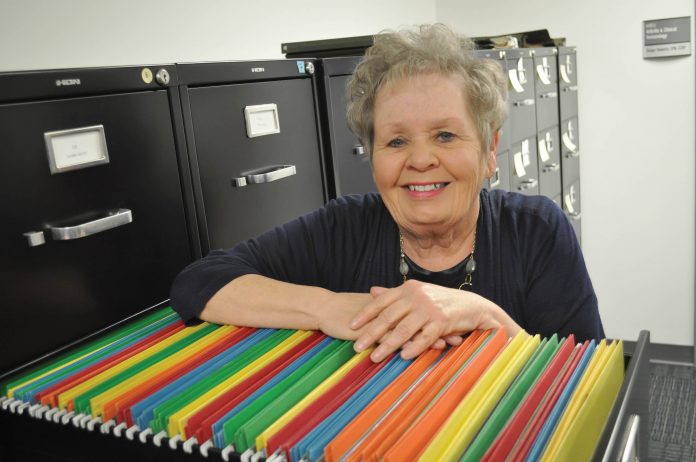
CAREERS IN NURSING
LPN GINGER ROBERTS DANCES THROUGH RESEARCH NURSING
by Bobby Anderson – Writer/Photographer
Thirty-six years in nursing have gone by for Ginger Roberts. Her career has spanned from clinic to hospital and now finds her on the cutting edge of research nursing working at the Oklahoma Medical Research Foundation.
And it all started when she wanted to be a nurse to coincide with the hours her kids would be in school.
Nearly four decades ago she went down to the local nursing school at Harris Hospital in Fort Worth, Texas and applied.
Her first job had her in an allergy clinic. She made allergens and administered the shots to patients.
In her 26 years she worked the night shift in OBGYN post-partum. She went to a medical surgical floor and then came to Oklahoma when her husband was transferred.
She started her Oklahoma nursing career on the south side of the city at Hillcrest on the orthopedic floor.
She worked chart audits before coming to Oklahoma Medical Research Foundation.
As luck would have it, she had just left her job and picked up a local newspaper to find an ad for an opening at the Oklahoma Medical Research Foundation.
“To me that sounded so exciting to be in research,” she said.
The secretary for Dr. Judith James soon called and set up an interview and she was quickly hired.
From day one, it was up to Roberts to recruit patients from James’ clinic for studies, complete their paperwork, take blood samples and run things from start to finish.
“We started with one study and now I’m at 34,” she said.
Not all the studies run concurrently but Roberts is responsible for making sure all the paperwork is in order for yearly inspection by the foundation’s institutional review board.
Currently, she’s running 12 studies. The number of study participants range from a handful to more than a hundred.
“You have to be highly organized and you have to know who’s on first,” she said. “I have file cabinets to prove everything is dotted.”
In her nursing career Roberts feels like she’s ending on a good note.
“This is the best,” she said. “What I do is a little bit of everything so there is something new all the time. Throughout the history of my employment I learned different things at each place and I can use that information here. This is kind of the icing on the cake. It’s really a nice place to work.”
Unless the Powerball comes through, Roberts says she plans on spending three or four more years working at OMRF.
“I work with probably the nicest physician I’ve ever known in my years,” she said. “She’s great to work for. She respects you and gets your input on things. She’s so smart and she’s taught me a lot about every disease we’ve studied.”
“It’s been a great big learning process for me. When I started here I didn’t know anything about rheumatology. Every study we do I learn a little bit more.”
With 11 possible symptoms, lupus is one of the hardest diseases to diagnose and even harder to treat.
When the immune system loses the ability to distinguish between dangerous interlopers—like viruses, bacteria and fungi—and its own cells, the body’s defense mechanisms become weapons of self-destruction. The resulting barrage of friendly fire can cause more than 80 different diseases. Chief among them is lupus, and OMRF has emerged a world leader in the study and treatment of this life-threatening illness.
OMRF scientists are part of an international consortium that has identified 13 genes specifically associated with the disease. The massive research project, which involves 150 scientists and nearly 7,000 research volunteers, has opened new frontiers in the quest to unmask the genetic culprits behind the disease.
Roberts says she learns something new each day. Seminars and conferences are always available for Roberts to increase her knowledge base.
Around OMRF, Roberts has picked up the reputation of being a stickler for detail. She’s meticulous when it comes to her patient records and super protective of her filing cabinets they reside in.
“I think they call me the HIPAA queen or something like that,” she said with a chuckle.
On this day, the records of more than 3,000 patients that Roberts has coordinated over the years were being pulled and put into a new filing system.
“It’s a big day. It’s a little stressful,” she said. “This week and next week I’m learning four new computer systems. I’m a little stressed out.
“My file cabinets are a really big mess right now.”



